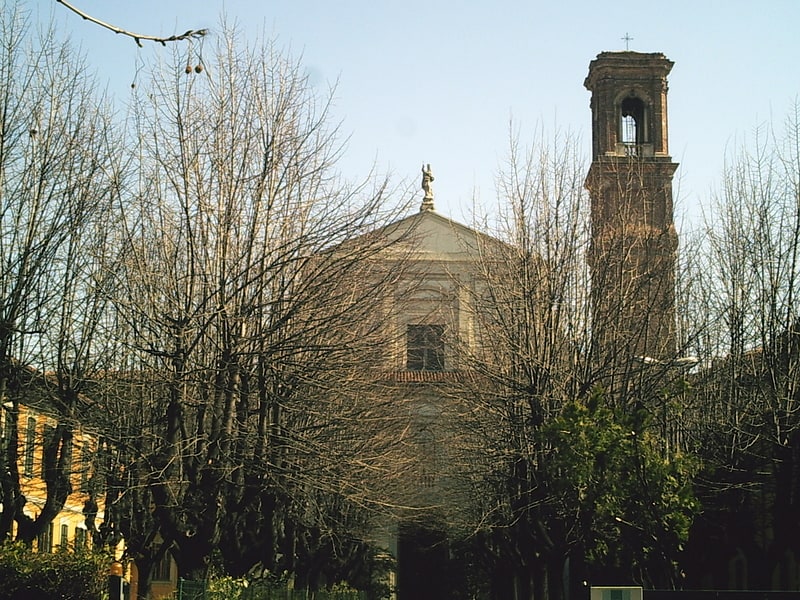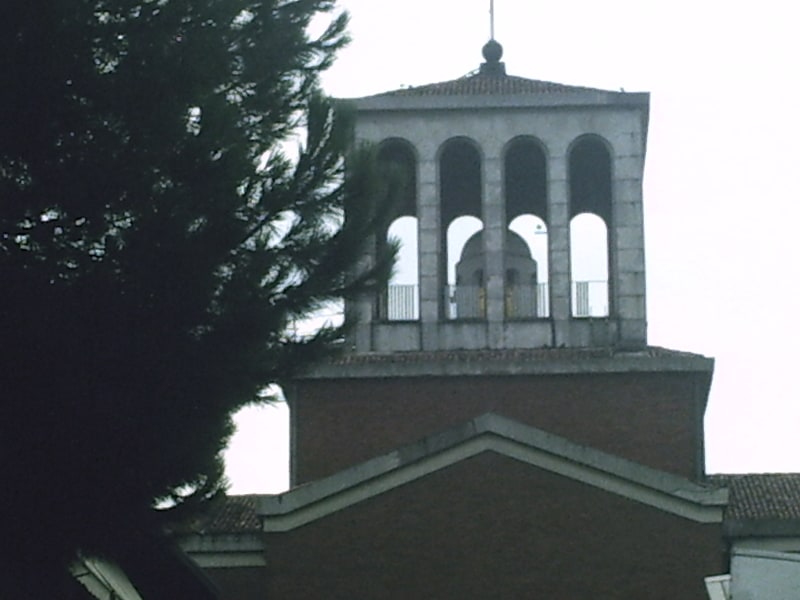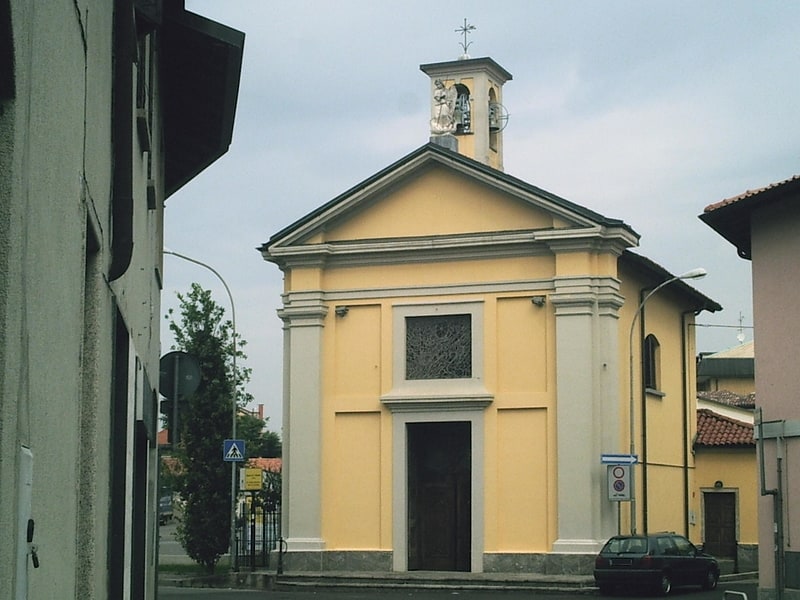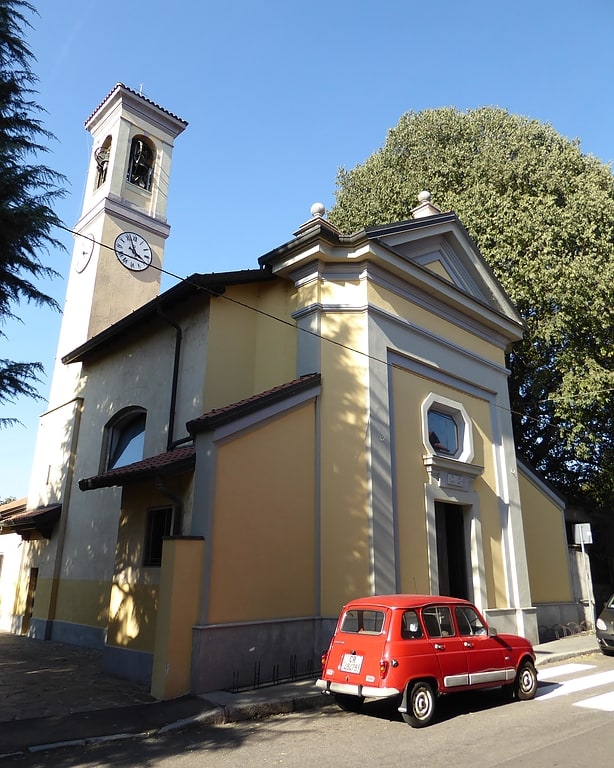Discover 6 hidden attractions, cool sights, and unusual things to do in Parabiago (Italy). Don't miss out on these must-see attractions: Sant'Ambrogio della Vittoria, Santuario di San Felice, and Madonna di Olzate. Also, be sure to include Church of Saints Gervasio and Protasio in your itinerary.
Below, you can find the list of the most amazing places you should visit in Parabiago (Lombardy).
Table of Contents
Sant'Ambrogio della Vittoria

The church of Sant'Ambrogio della Vittoria is a 14th-century church in Parabiago.
During the Battle of Parabiago in 1339 Luchino Visconti had been taken prisoner and tied to a walnut tree, but Saint Ambrose would appear to him and miraculously free him. In gratitude for the grace received it was decided to erect a church named after the saint at the site of the battle, the foundation stone of which was laid by Archbishop Giovanni Visconti. Completed in 1348, the temple was entrusted to chaplains appointed by the city administration of Milan, and every year, on the anniversary of the battle (February 21), a religious procession was held there in which the city's nobles participated.
In 1481 at the petition of the nobles of Parabiago, the church was entrusted to the Friars of the congregation of St. Barnabas and St. Ambrose ad nemus. In 1586 the people of Parabiago complained again about the friars' management of the church, and in 1647 the Council of LX decurions entrusted it to the Cistercian Fathers of Lombardy, who were able to take possession only in 1668. The monastic community had land holdings beyond the border with Nerviano, as far as the Olona River.
In 1606 the architect Alessandro Bisnati had been entrusted with the project for the renovation of the church, which, however, involving the demolition of the existing building, was deemed too costly. Demolition and reconstruction work began in 1624, and in 1647, when the building passed to the Cistercians, it was still not completed. Construction work on the new church and the adjoining monastery took place between 1708 and 1713, under the direction of architect Giovan Battista Quadrio. Following a visit by Elisabeth Christine of Brunswick, betrothed to the future emperor Charles VI of Habsburg in the first year of the work, the abbot obtained that a branch of the Riale (Röngia), known as the Röngieta, be built to irrigate the Cistercian properties, starting from the square and skirting to the right the street named after the church.
The bell tower was erected in 1723-1725 to a design by architect Pietrasanta. Also in the 18th century, the church was enriched with paintings and an organ, dated 1716.
In 1796, due to the French Revolution, the Cistercians were forced to sell their property, and in 1798 the order was also suppressed.
In 1799 the entire complex was used as a school for poor children, but under the French revolutionary regime, precisely in the republican year V (1806), it was bought by a Swiss man named Emanuele Odoni, who was immediately seized by the Administration of the Religious Fund. In the Republican year VI (1807) the monastery and other religious property were bought by the "Citizen" Manara, a personage, however, not well identified, and soon after by a certain Giovan Battista Litta Modignani; finally it was taken by a priest named Don Carlo Rota, who, wanting to compete with the Cavalleri College for Nobles, located in the square in front of the Prepositurale church in Parabiago, made it the seat of a similar educational institute; it lasted only a short time because Don Agostino Peregalli, Parish priest of Parabiago and rector of Cavalleri, absorbed it, moving the college from its historical seat in the square to the former Monastery, until 1857, when the renowned aristocratic school closed forever.
In 1864 Mrs. Rachele Peregalli, great-granddaughter of the aforementioned parish priest, sold the entire complex to Don Giovanni Spagliardi, who founded there the Pio Istituto per fanciulli derelitti, a reformatory whose "guests" in the village were nicknamed "barabitt," or little Barabbas. In 1869 it merged with the Marchiondi Institute in Milan, taking the name Opera Pia Marchiondi Spagliardi for juvenile assistance. But in 1924 the Parabiago branch closed its doors, moving permanently to the Milan branch.
The entire complex was declared a National Monument in 1913.
In November 1932, the Provincial Hospital Administration, bought the former monastery to make it a detached section of the Mombello "asylum," naming it Cerletti Psychiatric Hospital for Incurable Chronicles and giving it under administration to the Sisters of the Child Mary. Dismantled the old asylum, nowadays it is the headquarters of the ASL.
In the year 2006, a campaign began, carried out by the Lions Club Parabiago and the local cultural association El Bigatt, to promote the knowledge, recovery and reuse, religious and otherwise, of the monument in question. This campaign, with meetings and a conference held in the year 2007, which was also attended by eminent scholars and art critics, including then-Milan City Councilor for Culture Vittorio Sgarbi and Professor Emeritus Maria Luisa Gatti Perer, reached a first milestone with the restoration of the bell tower, the work on which was completed at the beginning of the year 2009.
The Parabiago Lions Club and the El Bigatt Cultural Association, with the intention of continuing the work and thus also carrying out the restoration of the church, promoted a conference on April 23, 2009, which, in addition to illustrating the work already done on the tower, also saw the presentation of the anastatic reprint, edited by the Parabiago Lions Club, of an important historical text by the author Maria Luisa Gatti Perer concerning this very monument.
Address: Via Giovanni Spagliardi, ., 20015 Parabiago
Santuario di San Felice

The sanctuary of San Felice is a church of modern construction within the historic center of Parabiago and depends on the parish of Saints Gervasius and Protasius. It was open for worship from the late 1940s until 1995, when the rector Marco Ceriani died, after which it was closed to the public. Very few religious services are currently held there.
On May 15, 1926, Senator Felice Gajo, signed a will in which he left his wife, Ida Lampugnani, the task of building a church after his death on December 31, 1935.
The project, entrusted to architect Giovanni Maggi, who succeeded in making the appearance of both a "mausoleum" in honor of the deceased and a place of worship for the local population, depicted a single-nave temple 39 m long and 12 m wide, with a huge square dome of the appearance of an imposing 38 m high mole, composed of 48 columns of white granite from Baveno.
The laying of the foundation stone took place on May 30, 1940, by Cardinal Schuster; the same Cardinal consecrated it on October 2, 1947, more than a year after its completion (July 11, 1946). When the work was completed, the facade was set back from the small churchyard, with a large niche above the main door, inside which is a statue of St. Felix Martyr by Dante Parini. Internally, the large nave is embellished with four columns in Alpi green and the altar in a central position.
However, within a few years of its consecration, the mammoth dome could not support its weight and at about 11 p.m. on January 20, 1950, it inexorably collapsed without claiming any victims, given the late hour the church was already closed to the public; immediately the architect Fernando Zanda was commissioned to design a new dome, still square and surrounded by columns, but much smaller than the previous one.
Inside, the church holds frescoes by Vanni Rossi, other sculptures and bas-reliefs by Parini, the Madonna of the Most Holy Rosary painting above the side altar of the same name and the 15 illuminated Mysteries on copper by Primo Lavagnini, a bronze bust of the Senator sculpted by Silvio Monfrini, and stained glass windows by Aristide Albertella. The shrine is devoid of bells.
Address: Via Felice Gajo, Parabiago
Madonna di Olzate

The shrine of Our Lady of God the Sà is a religious building located in the municipality of Parabiago, but dependent on the parish of Mary Mother of the Church in Nerviano.
Church of Saints Gervasio and Protasio

Also known as: Chiesa dei Santi Gervasio e Protasio
The church of Saints Gervasius and Protasius is the prepositural church of Parabiago, as well as the seat of the Pieve di Parabiago until 1972, when the Milanese parishes were dissolved.
The Pieve di Parabiago already existed in the 13th century: the communities of Arluno, Canegrate, Cantalupo (hamlet of Cerro Maggiore), Casorezzo, Cerro Maggiore, San Vittore and Uboldo depended on it.
The prepositura and pieve were abolished in 1582 by order of St. Charles Borromeo, and the church became a parish subject to the new pieve of Legnano. In 1841 Cardinal Carlo Gaetano di Gaisruck restored the prepositural title to it, and 4 years later he again established the pieve, comprising the same communities as in the Middle Ages, with the addition of San Giorgio su Legnano.
The church houses a historic 1841 Carrera organ; the current official organist is Pietro Ferrario, director of the choir Ensemble vocale Calycanthus.
Address: Piazza Giuseppe Maggiolini, 18, 20015 Parabiago
Saint Michael the Archangel Church

Also known as: Chiesa di San Michele Arcangelo
The Chiesetta di San Michele, is a church in the historic center of Parabiago, which depends on the Parish of Saints Gervasius and Protasius. It gives its name to the main street of the old San Michele district. On its left side opens Piazza Mercato.
Address: Via S. Michele, 81, 20015 Parabiago
Chiesa della Madonna della Neve

The church of Madonna della Neve is a religious building located in Ravello, a hamlet of Parabiago. Records of the original first construction of the church are lacking, although in the 13th century Goffredo da Bussero already mentions a church of Santa Maria, probably located in the hamlet, which at the time consisted of a number of noble villas.
In 1734 the ancient temple was being restored, but at the end of the 18th century, Parabiago parish priest Don Agostino Peregalli made a plea to the Milanese curia saying that the church was ". Too cramped, damp and ruinous, no longer amenable to restoration..." and at the same time excessively small, such that it could not hold even half of the approximately 130 residents in Cassina Ravello, as the village was called at the time.
Thus on January 4, 1794, a contract was awarded to Paolo Lamperti master builder, Master Carlo Lamperti and Master Giovanni Colombo Bongino, for the construction of the house of worship, designed by the great Parabiagian cabinetmaker Giuseppe Maggiolini. The construction lasted about a year, and the new church was blessed and consecrated by parish priest Peregalli himself on August 1, 1795.
From 1795 is the anonymous fresco, located in an elliptical niche above the altar and depicting Our Lady of the Snow with the Child Jesus, St. Roch and St. Catherine of Alexandria; in the same year a number of canvases were donated to the church, including the still-existing Crucifixion and Deposition. Still to be remembered is a tablet depicting the Madonna, Saint Roch and Saint Lucy in the foreground, in the background the countryside around Ravello with animals and peasants in adoration, and below it the inscription "By the grace of the Blessed Virgin this cassina was preserved from the cattle epidemic in the year 1746-47."